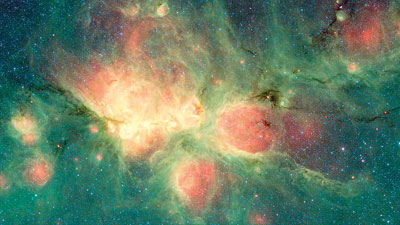NASA reveals stunning image of newborn stars in the Cat’s Paw Nebula
View(s):It’s the biggest footprint you’re ever likely to see.

THis second image from Nasa is based on data from IRAC alone, so this dust is not visible
This image from NASA’s Spitzer Space Telescope shows the Cat’s Paw Nebula, named for the large, round features that create the impression of a feline footprint.
It reveals gigantic ‘bubbles’ in the star forming region.
Framed by green clouds, the bright red bubbles are the dominant feature in the image, which was created using data from two of Spitzer’s instruments.
‘After gas and dust inside the nebula collapse to form stars, the stars may in turn heat up the pressurized gas surrounding them, causing it to expand into space and create bubbles,’ NASA said.
The green areas show places where radiation from hot stars collided with large molecules called ‘polycyclic aromatic hydrocarbons,’ causing them to fluoresce.
In some cases, the bubbles may eventually ‘burst,’ creating the U-shaped features that are particularly visible in the image below, which was created using data from just one of Spitzer’s instruments.

The nebula is a star-forming region in the Milky Way galaxy, located in the constellation Scorpius. This image was compiled using data from the Infrared Array Camera (IRAC) and the Multiband Imaging Photometer (MIPS) aboard Spitzer. Courtesy NASA
Spitzer is an infrared telescope, and infrared light is useful to astronomers because it can penetrate thick clouds of gas and dust better than optical light (the kind visible to the human eye).
The black filaments running horizontally through the nebula are regions of gas and dust so dense, not even infrared light can pass through them. These dense regions may soon be sites where another generation of stars will form. The Cat’s Paw star-forming region is estimated to be between 24 and 27 parsecs (80 and 90 light years) across. It extends beyond the left side of these images and intersects with a similar-sized star-forming region, NGC 6357. That region is also known as the Lobster Nebula – an unlikely companion for a cat.
Courtesy Daily Mail


